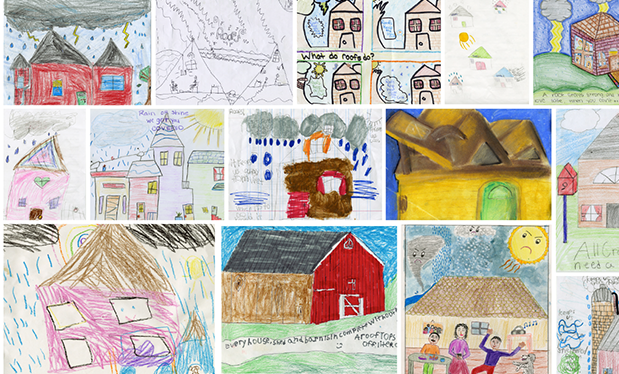Measuring, estimating and ordering materials—business as usual for all roofing companies—can prove tricky. But these tasks should be so simple you don't have to think about them at all. Technology can save time, reduce costs, help you obtain more business and give your company a competitive edge.
The following technology solutions are making routine manual tasks a thing of the past. After all, why do extra work when technology can make the work easier?
Roof takeoffs
How much time does it take to measure a roof? Who needs to be on-site, and what are their pay rates? Are there any additional safety precautions workers must take to complete an estimate? These are questions to consider before preparing to visit a location.
As any roofing professional knows, getting onto a roof can be risky. Residential properties often have steep-slope roofs with complicated structures. For roofs with slopes greater than 4:12, the Occupational Safety and Health Administration (OSHA) requires personal fall-arrest systems and other precautions to keep workers safe.
Whether a building is residential (steep-slope) or commercial (low-slope), there are several risks present given a roof's height. With about one in five worker deaths occurring in construction and falls being the most common cause of fatalities within this sector, according to OSHA, it is crucial roofing businesses find more ways to reduce worker exposures to risk.
Until recently, the best way to obtain roof measurements has involved climbing a ladder and using a measuring tape. Taking pictures while on a roof to get a clear view of structural features also may be desired. But without the proper fall-arrest system in place, taking a single photo could represent a disaster waiting to happen. And even if there is no disaster, blurry photographs taken from just one angle might not tell a roof's full story when it's time to begin work.
Advances in technology now can help roofing professionals pull together estimates without balancing on a ladder, struggling with measuring tape or snapping pictures. Instead, high-resolution, georeferenced aerial imagery can obtain needed details.
By using roof measurements derived from aerial imagery, you save a significant amount of time at the start of a job. Decreasing time spent measuring and taking photos also provides the opportunity to spend more time with prospective clients and better determine project requirements.
This extra attention given to a prospect's needs is sure to impress, but there's another advantage to showing up to a job site with a roof measurement report. Roofing contractors who already have information in hand, either in a printed report or a mobile app on a tablet, may appear more professional, forward-thinking and ready to work.
A property data report can combine roof measurements derived from aerial imagery with diagrams of a roof's facets, including length, width, area and slope. These data sets offer several aerial perspectives of a property as well as a 3-D rendering—they also can list the eaves, flashing and step flashing, hips, rakes, ridges and valleys on a roof.
Aerial photographs, diagrams and measurements help get all the details about a roof in one easy-to-understand format. Oblique views of a property from all four cardinal directions (north, east, south and west) as well as a top-down orthogonal perspective can capture what shaky smartphone pictures will miss.
The ability to streamline estimates and inspections using aerial takeoff technology also provides a competitive edge that allows more customers to be seen in shorter periods of time. Having property information readily available means the meeting doesn't need to be cut short to finish measuring or collecting other data.
Material ordering systems
What's better than a tech-savvy roofing professional with a fast bidding time and good customer service?
The answer is a tech-savvy roofing professional with a faster bidding time, better customer service and a superior material ordering system.
Once you win a bid for a job, the next step is ordering materials. Yet again, this can take a considerable amount of time if you aren't using technology to streamline the process.
Similar to taking measurements by hand, transforming measurements into a list of materials could take up to an hour. There's also the potential for human error. And if hand sketches and handwritten information are collected during an estimate, there are plenty of ways to accidentally transpose numbers or lose key data points.
All these "little" mistakes can render an estimate too high or too low. The result: lost business up front or a disgruntled customer later.
But let's say you've used a property measurement report. What can you do with this data once the order is ready to be placed?
Many distributors now offer 24/7 ordering capabilities online. These cloud-based applications, which can sync with measurements from a property data report, give users the ability to create custom order templates that pre-populate their preferred products or brands.
Roofing contractors who prefer ordering a specific brand of material from a supplier can set the brand as a preference every time they create an order. Using an online material ordering system also negates the need to scan or fax forms to a distributor or drop them off in person.
What does this mean for others around the office? For starters, there are no mysteries as to whether an order has been placed. Reviewing the order history in an online ordering platform will reveal the necessary supplies for each job. This, in turn, leads to better project management—no more sifting through paperwork or calling the distributor to sort things out.
Without knowing the exact measurements and details of a roof, you run the risk of ordering too many or too few supplies and delivering inaccurate estimates to customers. The resulting delays and price corrections could result in lost business.
Material ordering systems allow orders to be placed for exactly the amount of supplies needed without having to worry about overages or extra deliveries. By basing orders on aerial roof measurements, issues with returning extra supplies or having too few items to complete a job virtually are eliminated.
Insurance claims
A simpler estimation process coupled with comprehensive and accurate material orders speeds up the work for the average roofing contractor. But what about a roofing contractor who needs to help a property owner with roof system repairs after a storm?
During 2016, hailstorms caused billions of dollars in property damage, according to The Weather Channel.® In some parts of the U.S., strong winds and golf ball-sized hailstones smashed windows, destroyed vinyl siding and tore shingles off roofs. Hail season always brings a sharp increase in roofing jobs once a storm hits. So what's a roofing contractor to do?
After a major weather event, roofing businesses can be inundated with requests for repairs. If too much time is spent measuring roofs by hand, it slows down the workflow considerably, which could force customers to wait weeks or months for repairs to be completed—if the customers don't choose other contractors.
Sending the appropriate number of personnel into the field to perform estimates or inspections can be complex and costly for small businesses. Storm damage can make some roofs too unstable to climb safely, leading to an increased likelihood of a fall before a job has even begun.
Naturally, aerial roof measurements and a more straightforward material ordering process can help remove some of these obstacles. But it's not only roofing professionals who are using such technology. Insurance claims adjusters rely on similar information after property owners file claims for damage.
Typically, insurance adjusters need to visit the field to investigate claims and make an assessment. An insurance carrier may be responsible for hundreds or thousands of homes in the same ZIP code, which can bog down insurance adjusters and slow the claims process after a disaster. However, by using aerial imagery, insurance adjusters can spend their time assessing damage on an insured's property instead of wasting valuable time measuring the roof. This significantly can increase their customer satisfaction rating with homeowners because they have the time to properly assess damage on the first visit.
Some insurance carriers also are working with external services to gather drone footage, which is delivered directly to an adjuster's desktop. Contractors can take photos and add their own notes to give the adjuster more information.
Aerial imagery, automated property measurements and footage from drone flights all work together to prevent anyone from having to climb a roof, resulting in decreased risk for adjusters and the contractors who must make repairs. Just as these solutions allow roofing contractors to see more customers and win more bids, they're doing the same for insurance claims adjusters who need to make decisions fast.
Drones
More formally known as unmanned aerial vehicles, drones are operated remotely to fly low over properties and other terrestrial features. Drones with cameras or other sensors attached to them to capture aerial photos and videos are known as unmanned aerial systems (UAS).
Some drone tools have more sophisticated abilities beyond picture and video. These drones can perform laser scans from which photogrammetric point clouds are generated to create 3-D and 4-D models. The advanced capabilities of UAS make them especially useful in large-scale projects involving multiple phases.
Drones seem to be the new "it" toy for contractors, but all those bells and whistles may have some drawbacks for an average roofing contractor.
For one thing, the regulations surrounding drones are changing constantly. Roofing professionals who rely on drones to obtain property data are using them for profit, not fun. Therefore, they must abide by certain laws and restrictions for commercial drone use.
During the past year, the Federal Aviation Administration (FAA) has changed its regulations for drone use for commercial purposes. As of Aug. 29, 2016, the FAA issued a Part 107 ruling allowing individuals to fly drones for commercial reasons without a special exemption or pilot's license.
However, there currently are other eligibility requirements for drone pilots who use UAS for profit, as well as requirements they must follow before, during and after a flight.
Before flying a drone, drone pilots must pass an aeronautical knowledge exam and complete the necessary paperwork for a remote pilot certificate. During a flight, they must abide by certain rules, such as limits for speed and altitude set by the FAA. And though drone operators never intend to crash their UAS, they must report any accidents with property damage of more than $500 to the FAA within 10 days of the incident.
This, of course, raises the issue of flying a drone. In addition to getting the necessary clearance with the FAA to fly a drone commercially, taking the time to learn how to fly a drone—and fly it well—is a task unto itself. There are few things as disappointing as crashing something that cost thousands of dollars and paying a fine to the FAA.
Using drones to take aerial measurements and create 3-D models also requires additional skills from team members. Those without experience with photogrammetric software may find learning how to use a drone to be more burdensome than it's worth. On the other hand, working with a drone piloting program may be a happy medium for roofing contractors who need additional imagery with a roof report.
Drones may help contractors who need to inspect larger, harder-to-access structures that require up-close levels of detail. However, for the average residential or commercial property in need of a new roof system or other work, using a tried-and-true aerial roof measurement method can save the headache of learning several new systems at once.
New business opportunities
Regardless of whether you choose to work with drones, there are other high-tech opportunities to increase your business. The solar market may be a roofing contractor's best bet for expanding available services and increasing a customer base.
According to a report released by my company, EagleView, Bothell, Wash., this may be a wise investment strategy. Our research found solar industry revenue could annually increase 6.5 percent to $4.4 billion by 2021. Furthermore, about 75 percent of residential and commercial solar contractors surveyed reported they plan to invest in new technology during 2017.
An investment in technology should include more than what goes on a customer's roof. It's also necessary to invest in the bidding stages before the work can even begin.
It's necessary to know how viable a property is for solar power. In other words, will a homeowner or building owner be able to get the most out of a photovoltaic (PV) system?
The general rule for solar power is PV panels must face south. The roof slope and azimuth (an angular measurement in a spherical coordinate system) of the southern-facing portions of a roof are important factors when determining this viability.
Just as aerial roof measurements can aid in roofing and reroofing projects, they also can assist roofing contractors who need to know the slope, azimuth and area of a roof, as well as the locations of roof penetrations.
Roof measurement data can help determine the suitability of a PV system for a roof. It also can give solar contractors an idea of the energy savings a property owner could realize and how much he or she can depend on the solar power.
With this data, detailed diagrams of a roof, including measurements for all aspects of a roof, can be seen. The information not only helps sell PV systems to property owners, but through comprehensive roof data, it also can help reduce the number of PV system redesigns further into the project.
Changing the way
As is true with many industries, manual processes are falling by the wayside in the roofing industry. Climbing a ladder with measuring tape is becoming the obsolete way of gathering roof data. And just as some people are replacing trips to the supermarket with box services and Amazon Prime, roofing contractors are changing the way they order materials.
Technology also is enabling roofing contractors to work alongside insurance adjusters to help property owners after a storm. It's even letting roofing professionals break into new markets by giving them the information they need to sell sustainable solutions.
Piers Dormeyer is vice president of sales at EagleView, Bothell, Wash.
To read more about this topic, see:
"Endless possibilities," February 2017 issue
"Technology tips," October 2016 issue



